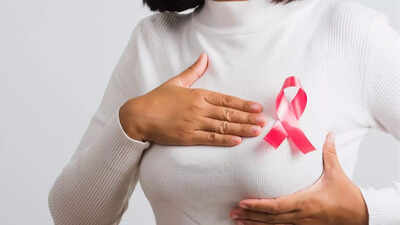
Breast cancer is often linked to lumps, but changes in the skin over the breast can be an early warning sign, sometimes appearing before a lump is detectable. These changes occur when cancer cells affect underlying tissue, lymphatic vessels, or blood vessels, altering the skin’s appearance, texture, or sensation. Common skin-related signs include dimpling, redness, thickening, nipple changes, and in advanced cases, ulcers or sores. Recognising these changes early is vital, as timely medical evaluation and intervention can significantly improve outcomes. Being aware of what to look for empowers women to detect potential breast cancer sooner.
How breast cancer can show through changes in your breast skin
Dimpling or puckering
One of the most common skin-related signs of breast cancer is dimpling or puckering. The skin may start to resemble the texture of an orange peel, a condition medically known as peau d’orange. This happens when cancer cells block lymphatic vessels in the breast, causing fluid buildup and swelling. The trapped fluid pushes against the skin, creating a pitted or dimpled effect. Dimpling may be subtle at first but can become more noticeable over time. A study published in NIH, examined 26 mastectomy specimens from patients with breast cancer who exhibited peau d’orange. The researchers found that tumor cells were present in the lymphatic vessels in areas of peau d’orange in 38% of the specimens studied. This finding depicts the importance of recognizing peau d’orange as a potential indicator of underlying malignancy. Any new or unusual puckering, especially if it appears on one breast, should prompt an immediate visit to a healthcare professional.
Redness or inflammation
Redness, warmth, or swelling of the breast skin may signal inflammatory breast cancer, a rare but aggressive form. Unlike a typical rash, the redness usually covers a large area, often the entire breast, and may be accompanied by tenderness, a heavy feeling, or rapid enlargement of the breast. Inflammatory breast cancer can develop quickly and may not produce a noticeable lump, which is why recognising skin changes is vital. Persistent redness that does not resolve, or is different from a minor irritation or infection, should be evaluated by a doctor without delay.
Thickening or firmness
Areas of the skin may feel unusually thick, firm, or tight. This change occurs when underlying tumor growth affects the tissue beneath the skin, altering its consistency. The skin may feel harder than surrounding areas and sometimes appears stretched. Thickening alone can be subtle, but when combined with redness, dimpling, or nipple changes, it becomes a more concerning sign. Monitoring any new firmness in the breast skin can help catch potential cancers early.
Nipple changes
The nipple and areola may also show visible signs of breast cancer. Nipple inversion, persistent itching, scaling, crusting, or discharge, especially if bloody or clear, can indicate underlying malignancy. A rare type of breast cancer called Paget’s disease of the breast often begins as redness, flaking, or ulceration of the nipple skin. Even minor or gradual changes should not be ignored, as early diagnosis dramatically improves the effectiveness of treatment.
Ulcers or open sores
In more advanced cases, cancer can lead to the development of ulcers or open sores on the breast. These sores may bleed, ooze fluid, or fail to heal, often appearing alongside thickening, redness, or dimpling. While less common, persistent sores are considered a serious warning sign and require immediate medical evaluation. They are typically associated with aggressive cancers and highlight the importance of not delaying medical attention.
Spotting changes early: Key to better breast cancer outcomes
Being aware of these skin changes is a crucial part of breast self-examination and routine check-ups. Women should regularly examine their breasts, looking for any unusual alterations in texture, colour, or shape. If any persistent changes are detected, it is important to consult a healthcare professional promptly. Diagnostic tools like mammography, ultrasound, or biopsy may be used to confirm the presence of cancer. Early detection significantly improves treatment outcomes and reduces the risk of the cancer spreading to other areas.Changes in breast skin, such as dimpling, redness, thickening, nipple alterations, or sores, can be among the earliest signs of breast cancer. Understanding these changes and seeking timely medical evaluation can save lives. Regular self-exams, combined with routine clinical check-ups, remain essential strategies for early detection and effective treatment of breast cancer.Disclaimer: This article is for general informational purposes only and is not a substitute for professional medical advice, diagnosis, or treatment. Always seek the guidance of a qualified healthcare provider regarding any medical condition or lifestyle change.Also Read: 7 Best stretches for people over 60 to improve flexibility strength and mobility








